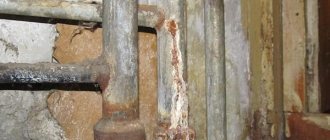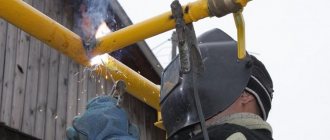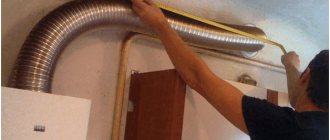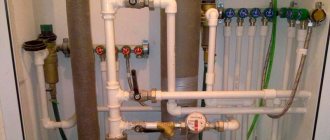In theory, this is very good when the utilities in the house replace the gas pipes with new ones. You get reliable, modern communications and pay nothing for it. At first glance, these are all advantages, right? But in order for the process to go smoothly and not end in damage to personal property, you need to carefully prepare for it.
We have found out how the repair/replacement of gas pipes in an apartment building takes place and we will tell you in detail everything that will help you go through the repair work calmly.
Why change the gas pipeline: the main reasons
Centralized gasification is one of the modern benefits for the population living in apartment buildings. Most of the houses were built in the vast expanses of the Soviet Union, so some of the communications are very outdated and worn out. In this regard, the state is conducting a capital repair program, in which gas pipes are replaced free of charge in each apartment.
The capital repair program provides for free replacement of all gas pipeline components.
There are several reasons for replacing a gas pipeline in an apartment in a multi-story building:
- there was a gas leak (in this case, part of the riser is replaced in the apartment where the problem was discovered);
- the pipes are worn out, initial damage to the pipe coating is visible;
- The service life of pipes has come to an end - this happens in houses built more than 50 years ago.
Mosgaz reports that the replacement is a planned procedure. At the same time, each resident of an apartment building must provide access to their home at a specified time so as not to interfere with the work of the craftsmen. Usually, before such a major repair, the local housing and communal services notify all residents of the building about the impending work, so everyone should be aware of the major repair.
Regulations and rules of work
Current legislation states that only employees of the gas supply company have the right to repair gas communications. To determine the scope of work, a preliminary check is carried out. The technicians visit all apartments, inspect communications and make notes regarding the level of wear of networks and locking elements. Based on this information, a decision is made regarding the purchase of materials and the upcoming scope of work.
When visiting the site, the team is provided with an order sheet, which clearly indicates the list of planned activities. All masters carry company employee identification cards with a photograph and a hologram.
Residents in apartment buildings are prohibited from installing/dismantling gas supply lines themselves. If such a case is detected, an administrative fine will be imposed on the apartment.
The work is carried out at public expense in accordance with current regulatory requirements. Old pipes are removed and heavy-duty new ones are installed in their place. They are selected depending on the pressure level in the city network. At the same time, all shut-off valves are changed. There is no charge to residents for this.
The need for replacement during a major overhaul: is it possible to refuse?
It often happens that carrying out work during a major renovation causes some discomfort to the residents of the apartment whose riser is currently being replaced. Many residents are afraid of damage to other equipment, so they seek to enter into an additional agreement with the contractor. Unfortunately, the contractor is not obliged to conclude documents with each apartment owner. This repair is a replacement of common property equipment and each apartment owner must provide access to service workers.
Service employees must notify residents of the expected date of work.
It also makes no sense to refuse to carry out work. The need is determined by the poor, worn-out condition of the gas pipeline, which will entail negative consequences in the future.
If the resident does not provide access to the apartment, then workers will not be able to completely replace the riser. This will result in a shutdown of the gas supply and dissatisfaction on the part of the neighbors in the riser. If work is refused in the apartment of the refused owner, the gas will be completely shut off.
*
SNIP rules
In case of violation of installation rules, serious penalties may be applied to apartment owners.
According to the current SNIP, there are certain rules and regulations that should be taken into account when implementing or planning gas pipeline reinstallation:
- The distance of gas pipes that are laid openly indoors to any other structures or communications should take into account the further possibility of repair, replacement or preventive work with them.
- It is prohibited for gas pipelines to intersect with door or window openings, as well as ventilation.
- The distance between such pipes and any wired communication means must be no less than that established by safety regulations.
- The minimum distance that must be between the gas pipeline and any types of power supply communications must be observed in accordance with the PUE.
- When gas pipes are laid open, brackets, hooks, hangers or clamps should serve as fastening elements. Moreover, the distance between them is also defined in SNIP.
- To lay a liquefied gas pipeline, a prerequisite is the presence of a slope, which should be 3 percent or more
Please note: if a meter is installed in the apartment, the slope will be calculated from it.
Rules for replacing gas pipes in the kitchen
Gas pipes are the most important element of the gas supply system to the apartment. They connect the main gas pipeline of an apartment building with the gas pipeline in each apartment. When replacing pipes required for a major overhaul, the procedure is to dismantle the old one and install a new gas pipeline in the kitchen. Often, service workers replace old pipes with flexible hoses, and shut-off valves are also replaced. The entire work procedure must be regulated in a special document.
Attracting gas service employees
The houses included in the capital repair program are equipped with outdated gas pipes, so the involvement of local service workers is inevitable. The program provides for the safety of all residents in an apartment building, so it is important that professionals do the work. There are several criteria by which you can distinguish a gas service employee from other persons trying to make money from residents:
- the employee is dressed in a special uniform with reflective stripes and has the name of the performing service on the back;
- the employee must provide the tenant with his identification signed and stamped by the head of the gas service;
- the ID must contain a photograph of the employee, his data, the service logo, the name of the department, as well as a seal and a hologram;
- If a resident has any doubts, he has the right to call 104 to clarify the official inspection schedule.
Specialists perform all work in accordance with legal protocols and regulations.
The work is being paid for by the Capital Improvement Fund, so residents are not charged anything. Gas service employees come to the apartment at the appointed time and carry out a number of works, the result of which must comply with legal regulations. Residents are prohibited from reconstructing the gas system on their own - because of this, a fine may be imposed on the apartment.
Requirements for the selection of materials
Before installing new pipes throughout the house, the contractor must purchase the material. All materials must comply with standards and requirements. Often the gas system is located in the kitchen: it is the source for supplying the resource through the stove, and is also sometimes used for heating using a boiler. By law, the following requirements must be met:
- Fire safety. For gas pipes it is necessary to choose steel, copper and polypropylene pipes. Each of the listed materials allows for complete sealing of the seams, therefore, leaks should not occur.
- Gas pressure. This indicator should not exceed the norm established by SNiPs - 0.003 MPa.
- Requirements for steel pipes. Products must be made of mild low-carbon steel grades St2, St3, and St4. Gas supply pipes must have special certificates confirming that the products can withstand hydraulic pressure.
- Connection requirements. All fittings must be manufactured in accordance with GOST. Elbows, tees, and couplings are made of malleable cast iron with cylindrical threads. The rivets and locknuts must be steel and have cylindrical threads. Transitions and plugs are made of steel followed by welding. All parts must be of factory origin.
- Requirements for shut-off valves. When choosing a material, you must remember the temperature and gas pressure. For the production of locking elements, gray and ductile cast iron, carbon and alloy steel, as well as brass and bronze are used.
Each element must comply with SNiPs, otherwise the replacement will not be carried out according to the rules.
*
Gas services are required to comply with all requirements stipulated by the code of regulations for repair work. If problems or gas leaks occur, the contractor is responsible for the work.
Stages of work organization
Before gas service employees begin repair work, a routine inspection of each apartment will be carried out. It is on this basis that the conclusion is made that the multi-apartment residential building requires replacement of gas pipes. The first thing you need to do to find out whether a house falls under the repair program is to go to the gas service website and find your address. If it is on the list, then you should expect a visit from repairmen in the near future.
Workers must check the system after replacement.
Often, the entire procedure for replacing pipes for a home lasts 3-4 days, this creates some discomfort for residents, but this process ensures further safety. During the initial inspection, the gas service employee makes notes about what problems there are in the apartment regarding gas equipment and pipelines. When the repairmen arrive at the apartment, the work will proceed as follows:
- Preliminary information about preparation. Often such information is available on the website of the local city gas service. Additionally, workers post a notice on the building stating that each resident must ensure that an employee gets into the apartment. Residents must completely remove all obstructions and kitchen furniture that block free access to the gas system.
- Carrying out work. Gas service employees often replace pipes at the entrance. Replacing a gas riser takes 4 hours of working time, therefore, every resident must be at home during this period of time. The craftsmen turn off the gas, cut the gas pipe, and install a new pipe.
- At the next stage, new pipes are soldered to the gas pipeline, before which the remaining old gas is removed from it by blowing.
- Security check. Using a soap emulsion, gas workers check the integrity of the welds, and also examine the presence of all plugs and the serviceability of the connections in each apartment.
Old communications are subject to mandatory replacement, so residents must provide access to service workers.
*
Only after a safety check is it allowed to let gas through the pipes of the house. During startup, the gas pipeline must be purged to displace all the air from it.
Rules for making welded joints
Depending on the wall thickness of the gas pipe, the type of welding will be selected. For example, for wall thicknesses up to 4 mm, gas welding or electric welding is used. Often in apartments, when replacing during major renovations, steel pipes with a diameter of 21.3 to 42.3 mm are used.
The weld seam must be neat and even, and also comply with established standards.
The rules for making welds include:
- before starting the procedure, the edges of the prepared pipes must be cleaned of dirt and corrosion;
- if products with a wall thickness of more than 4 mm are used, then bevels are made on the edges - this helps to achieve rapid melting of the steel;
- the movement of the burner should occur from right to left: it passes through those areas of the product that have not yet been welded;
- there should be no metal splashes, scale or other contaminants around the weld;
- There should be no undercuts, burns or cracks on the surface after work.
If there are defects, gas service employees must redo the work to ensure the safety of the apartment residents.
Some tips for residents
Access to gas pipes to be replaced must be convenient and free. Furniture or interior fragments blocking access to communications must be dismantled by the owner of the premises on his own.
It is this moment that often causes the most complaints. Property owners who have completed a major renovation in the kitchen do not want to disassemble kitchen units, move household appliances, or disturb the finishing of walls and ceilings. However, this cannot be avoided if the repair of gas pipes in an apartment building is already planned.
During the period of work, it is better to remove most breakable items and small household appliances from the kitchen. This will avoid accidental damage to property during repairs.
To minimize the negative aspects associated with replacing gas communications, you need to properly prepare the room for the visit of the experts. It is better to cover the front part of the cabinets with something thick so that workers do not accidentally scratch the doors. If a glass hob is installed in the kitchen, it must be protected especially carefully.
Rugs, table and chairs should be taken out for a while. The same applies to fragile decorative items, vases and table lamps. Of course, this is not very convenient, but in this way you will reliably protect your property from any surprises.
It is not advisable to leave the team unattended for a long time. The owner constantly appearing in the doorway will force the craftsmen not to delay the process and do their work much more carefully.
Replacing a pipe with a hose
In Soviet times, gas stoves were connected using steel pipes to the gas pipeline by welding. Today, such a design is impractical and during major repairs, employees will replace the old pipe with a flexible hose. This device allows you to move the stove to a convenient distance when carrying out independent repair work inside the apartment.
Several types of flexible hoses can be used to connect the slab:
- made of rubber and fabric;
- made of rubber braided with metal;
- bellows metal hose.
A flexible connection will allow you to move the stove to the required distance.
*
The last option is considered the most common - it is strong and reliable. It is a metal in a corrugated shell that can bend. The pipe is cut off to avoid static charge using a dielectric insert between the tap and the hose. The stove is connected to the hose, then the metal mesh included in the kit is inserted - it protects the burner from contamination. Both ends of the hose are tightened with a wrench. At the final stage, a safety check occurs using a soap emulsion.
Features of pipeline dismantling
This type of activity has its own specifics regarding the practical implementation of work. Dismantling the line begins with choosing a method for removing the structure. There are three ways to disassemble an area:
- dismantling work is carried out by preparing a trench;
- using conventional loosening, which is suitable for certain types of soil;
- To dismantle pipelines, the method of pulling the structure is used, which is especially effective if the line passes under a road or communications.
The most common methods include cutting metal parts using automatic welding machines. This option is especially widely applicable in populated areas. In order to dismantle a pipeline in an area remote from the area of active human activity, the blasting method can be used. The method of directed explosion is acceptable for use in populated areas. In this case, the dismantled structures are removed with the least amount of time. Its use is possible if a reliable fence is created around the object.
Dismantling must be carried out under the following conditions:
- the line must be disconnected from operational sources;
- There should be no working fluid inside the dismantled pipes, especially gas compounds, oil products, or aggressive media;
- all technological devices ensuring the operation of the line must be inoperative.
Dismantling of pipes must be carried out in compliance with the requirements of Russian legislation. The list of mandatory documents includes fire safety standards, rules for the operation of oil pipelines, and instructions for the repair of gas pipelines.
Photos of dismantling
Recommendations from experts
Major renovations are always unexpected for residents. The main advice for tenants is to carefully prepare for the arrival of gas service workers, so that subsequently there will be no problems with property damage. Some apartment owners are wondering what to do with tenants if the building undergoes a pipeline replacement? They must be notified in advance about the arrival of the service employee, and also be personally present when signing the documents.
Basic recommendations from replacement specialists:
- gas service workers will have to change the meter, so residents should think in advance about how it will be located and where it will be hidden;
- During the period of replacement of the riser in the house, the gas is turned off to the residents, so it is better to use electric appliances for cooking;
- workers must install a gas shut-off valve, and if there are other gas appliances, shut-off valves must also be installed to them;
- the pipe is secured to the wall using clamps or brackets;
- The slope of the gas pipeline system from the meter should be 3%.
At the request of the owner, the meter can be installed in the place specified by the owners.
Upon completion of the work, the repairmen draw up a special act, which is signed by the owner of the apartment. The act indicates all the changes that were made when replacing the gas pipe. The owner is also issued a passport for the meter. Before signing the act, you should check everything thoroughly, because the signature will mean full acceptance of the work.
Checking the entire system for leaks and operability
Leaks are checked using a soap solution
The test is done after installation is completed, leaks and performance are diagnosed. First, the general appearance of the system is inspected, the connections are checked, the fittings are tightened, and compliance with the design diagram is checked. Gas emissions are detected at connections and assemblies.
A soap solution is used to coat the joints of pipes with a hose, the interface between a flexible hose and a stove or oven. If bubbles form, the node requires revision and re-diagnosis. The master draws up a report of completed work describing the features, changes are entered into the technical passport.
Possible errors when replacing
Malfunctions when replacing a gas pipe under a major repair program pose a huge danger to residents of the entire building. A gas leak can easily cause an explosion, so it is worth knowing about possible mistakes made by workers, including incorrect connection of gas equipment, as well as the use of low-quality materials.
After signing the acceptance certificate, the contractor is not responsible for the subsequent use of gas.
Residents of an apartment should be alerted by a sudden stop in the supply of gas to the water heater or stove, as well as the smell of gas in their apartment or in the entrance. In case of emergency situations in your own home, it is recommended to turn off the taps and call the gas service. If there is a suspicious smell of gas in the entrance, you must contact the management company or housing and communal services.
It is prohibited by law to reinstall or test gas pipes yourself. After the procedure for replacing the riser for major repairs, you can continue to use the stove as usual, and in case of suspicious situations, call the gas service.
New rules for connecting gas to a private home in 2021
Until recently, connecting gas to a private home was a very expensive and painstaking task. Due to the fact that there were no clear prices and this area was monopolized, the cost of services was set by local government, and sometimes it reached 0.5 million rubles. After changes in laws on gasification, installation time began to be about 1-1.5 years, and the price for individuals was 20-50 thousand rubles.
If the central gas main is located more than 200 m from you, connection will be difficult. If you want to install gas for yourself, then this is pointless, since the cost of this project can be several million. The only way out is to cooperate with other residents of your locality and write an application. If the number of signatories is sufficient, then gas will be supplied to your city or town free of charge, and all you have to do is follow the steps described above.











